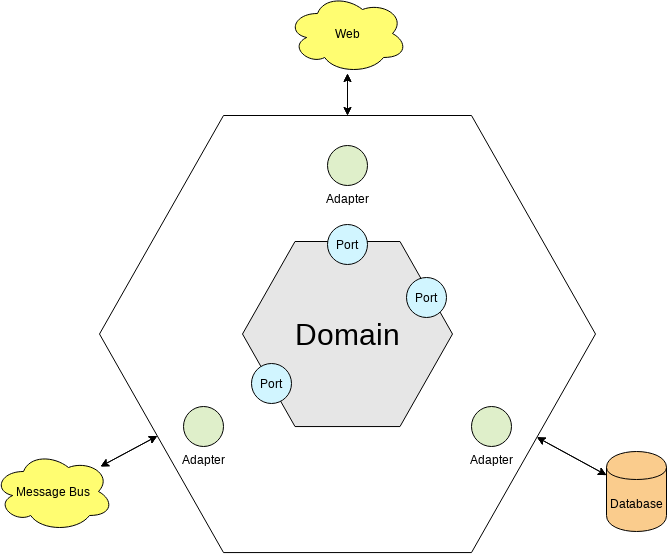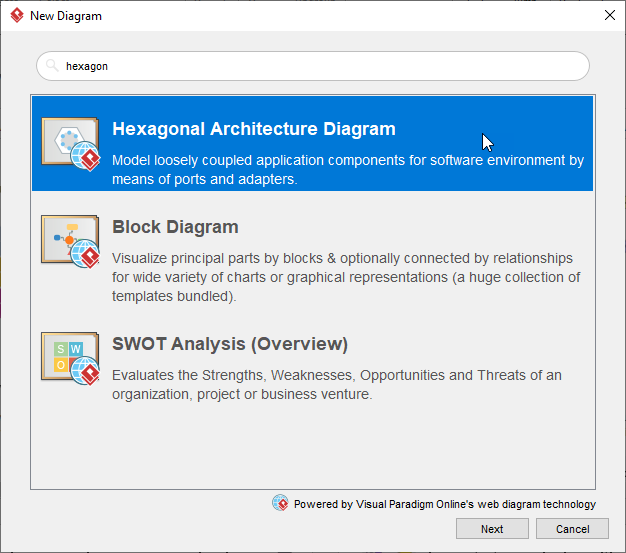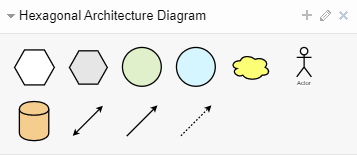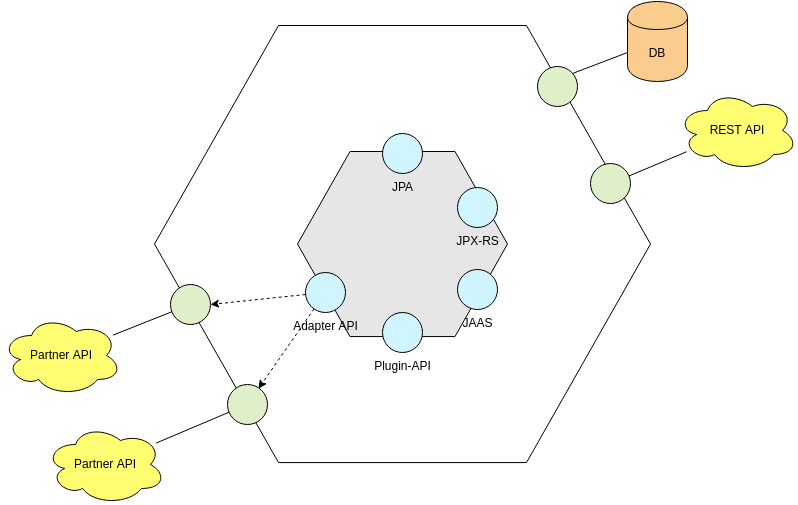What is a Hexagonal Architecture Diagram?
Hexagonal architecture diagram, also known as ports and adapters architecture, is a software architecture pattern that aims to make software systems more maintainable, testable, and adaptable to changing requirements. It is a way of organizing the code of a software system in such a way that it remains independent of its external interfaces, such as databases, user interfaces, or third-party services. The hexagonal architecture diagram provides a clear separation between the business logic of the software and the external dependencies, making it easier to manage and maintain the software over time.
The figure below shows an example of a hexagonal architecture diagram.

The hexagonal architecture diagram is called hexagonal because it is typically represented by a hexagon with the business logic at the center and the external interfaces at the edges. The hexagon shape represents the idea of having a core business logic that is surrounded by a protective layer of adapters that allow the system to communicate with the external world.
History of Hexagonal Architecture Diagram
The hexagonal architecture diagram was first introduced by Alistair Cockburn, a well-known software development expert, in 2005. Cockburn proposed the hexagonal architecture diagram as a way of making software systems more adaptable to changing requirements. The idea behind the hexagonal architecture diagram was to create a flexible architecture that could evolve over time without breaking the existing code.
Since then, the hexagonal architecture diagram has gained popularity among software developers as a way of creating more maintainable and testable software systems. The hexagonal architecture diagram has been used in a variety of software systems, from web applications to embedded systems, and it has proven to be an effective way of organizing code.
When to Use a Hexagonal Architecture Diagram?
The hexagonal architecture diagram is best suited for software systems that need to be highly maintainable, testable, and adaptable to changing requirements. It is particularly useful in situations where there are many external dependencies that need to be managed, such as databases, third-party services, and user interfaces.
The hexagonal architecture diagram is also well-suited for agile software development methodologies, as it provides a way of creating software that is flexible and adaptable to change. The hexagonal architecture diagram makes it easy to change the external interfaces of a software system without affecting the internal business logic.
How to Create a Hexagonal Architecture Diagram with Visual Paradigm?
Creating a hexagonal architecture diagram in Visual Paradigm is straight-forward:
- Click on the Diagram menu.
- Click on the New button.
- Select Hexagonal Architecture Diagram and click Next. Note that you have to create a VP Online account to continue. Creating an account is free.

- You can now create the diagram with the symbols on the left.

Hexagonal Architecture Diagram Examples
Hexagonal Architecture Diagram Example 1:

Hexagonal Architecture Diagram Example 2:

Hexagonal Architecture Diagram FAQs
What are the benefits of using a hexagonal architecture diagram?
The hexagonal architecture diagram provides several benefits, including increased maintainability, testability, and adaptability. It allows the business logic of a software system to be separated from its external dependencies, making it easier to manage and maintain the code over time. It also makes it easier to test the business logic of a software system in isolation, without having to worry about the external dependencies.
What are the disadvantages of using a hexagonal architecture diagram?
The main disadvantage of using a hexagonal architecture diagram is that it can be more complex than other software architecture patterns. It requires careful planning and design to ensure that the software system is organized in a way that makes sense and is easy to maintain over time. It may also require more development time and resources upfront, although this investment can pay off in the long run with a more adaptable and maintainable system.
Can a hexagonal architecture diagram be used with any programming language or technology?
Yes, the hexagonal architecture diagram can be used with any programming language or technology. It is a software architecture pattern that is language- and technology-agnostic, meaning that it can be applied to any software system regardless of the programming language or technology used. However, the implementation details of a hexagonal architecture diagram may vary depending on the specific programming language or technology being used. For example, the way that external dependencies are managed may differ between programming languages or technologies.
Is the hexagonal architecture diagram a good fit for microservices architectures?
Yes, the hexagonal architecture diagram can be a good fit for microservices architectures. In fact, it is often used in conjunction with microservices architectures as a way of organizing the code of individual services. The hexagonal architecture diagram provides a way of ensuring that each microservice is well-organized and easy to maintain, while also ensuring that the microservices can communicate with each other and with external dependencies in a standardized way.
Can the hexagonal architecture diagram be used with legacy code?
Yes, the hexagonal architecture diagram can be used with legacy code. In fact, it is often used as a way of refactoring legacy code to make it more maintainable and adaptable to changing requirements. By applying the hexagonal architecture diagram to legacy code, it is possible to create a more modular and testable software system that is easier to work with over time.
Want to Learn More about Hexagonal Architecture Diagrams?
The references below provide you with more information about the hexagonal architecture diagrams..
- “Hexagonal Architecture: Three Principles and an Implementation Example” by Alistair Cockburn – This article explains the three principles of Hexagonal Architecture and provides an example of implementing it.
- “Hexagonal Architecture” by Dr. Venkat Subramaniam – This article discusses the Hexagonal Architecture pattern and provides a detailed diagram of its components.
- “Hexagonal Architecture with Spring” by Baeldung – This article provides an example of implementing Hexagonal Architecture using the Spring framework, and includes a diagram of the architecture.

